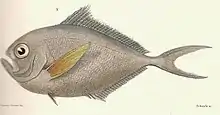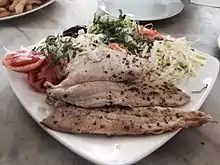Brama australis
Brama australis , the Southern Ray's bream or Pacific pomfret, is a species of marine ray-finned fish from the family Bramidae, the pomfrets. It is found in the southern Oceans.

| Brama australis | |
|---|---|
 | |
| Scientific classification | |
| Domain: | Eukaryota |
| Kingdom: | Animalia |
| Phylum: | Chordata |
| Class: | Actinopterygii |
| Order: | Perciformes |
| Family: | Bramidae |
| Genus: | Brama |
| Species: | B. australis |
| Binomial name | |
| Brama australis Valenciennes, 1838 | |
| Synonyms[1] | |
|
Brama chilensis Guichenot, 1848 | |
Description
Brama australis has the typical laterally compressed body of a pomfret with a single dorsal fin which has no spines but contains stiffened fin rays. The anal fin also has no spines and contains fewer than 29 rays. The anal fin is similar to the dorsal fin but lacks the high anterior lobe of the dorsal fin. It grows to a maximum standard length of 53 centimetres (21 in).[2]
Distribution
Brama australis is found throughout the subtropical to sub-antarctic waters of the whole Southern Pacific Ocean from New Zealand to Chile.[3] It may have a circumpolar distribution in the Southern Hemisphere below 20° South.[2] It is a highly migratory species.
Habitat and biology
Brama australis is a pelagic species which lives at depths of 15 to 120 metres (49 to 394 ft).[1] It is a carnivorous species which feeds on the krill Euphasia mucronata in the southern summer off Chile, other crustaceans such as Pterygosquilla armata and hyperid amphipods are also important parts of its diet.[4] It has also been reported to feed on crabs, squids and small fishes.[5] It is a highly migratory species.[3] It is a relatively fast growing species which can attain its full length in 8-9 years.[5] The Southern Ray's bream has been found to be host to 12 species of metazoan parasites, the most common were the copepod Hatschekia conifera with the larvae of the cestode Hepatoxylon trichiuri being the next most important.[6]
Utilisation
Brama australis is mainly caught using long lines and gill nets by artisanal fisheries off Chile. The species is heavily exploited and may be on the verges of being overfished.[3] Rarely caught elsewhere, usually as bycatch in tuna fisheries.[2]


References
- Froese, Rainer; Pauly, Daniel (eds.) (2019). "Brama australis" in FishBase. December 2019 version.
- P.R. Last & M. Moteki. "Bramidae". FAO.
- "Southern rays bream". FishSource. Retrieved 9 November 2020.
- Francisco Santa Cruz; Ciro Oyarzún; Gustavo Aedo; Patricio Gálvez (2014). "Hábitos tróficos de la reineta Brama australis (Pisces: Bramidae) durante el periodo estival frente a Chile central". Latin American Journal of Aquatic Research (in Spanish). 42 (5): 1200–1204. doi:10.3856/vol42-issue5-fulltext-24.
- Ciro Oyarzún; N. Cortes; Elson Mauricio Leal (2013). "Age, growth and mortality of southern rays bream Brama australis (Bramidae) off the southeastern Pacific coast". Revista de Biologia Marina Y Oceanografia. 48(p (3): 585–590. doi:10.4067/S0718-19572013000300014.
- M. E. Oliva; J. F. Espinola; L. A. Ñacari (2016). "Metazoan parasites of Brama australis from southern Chile: a tool for stock discrimination?". Journal of Fish Biology. 88 (3). doi:10.1111/jfb.12881.